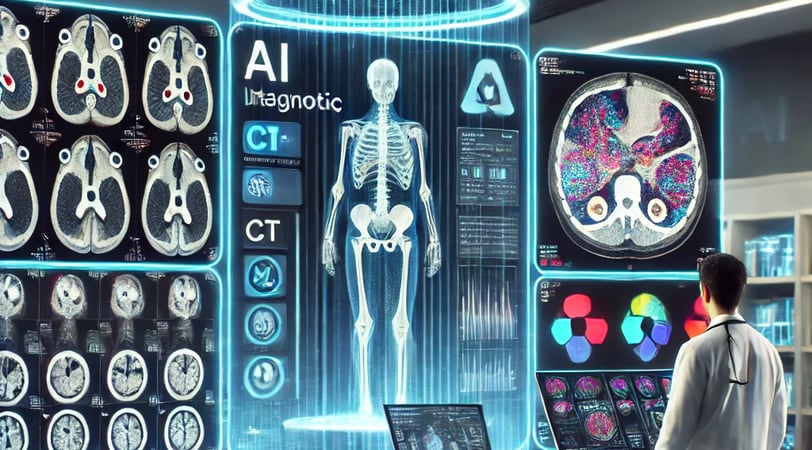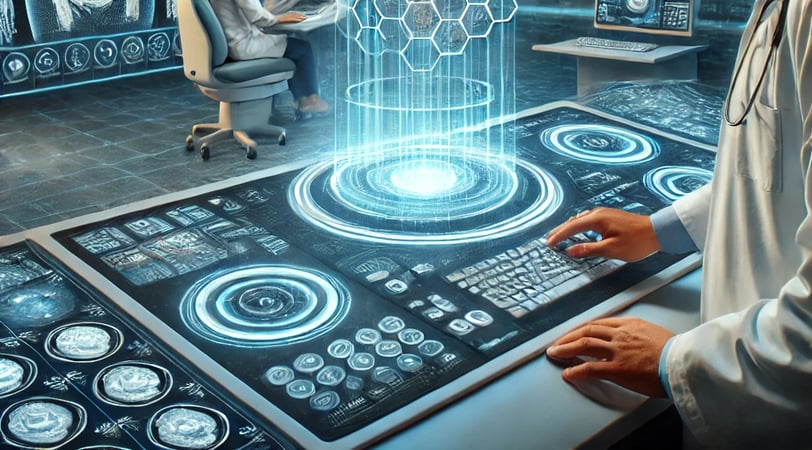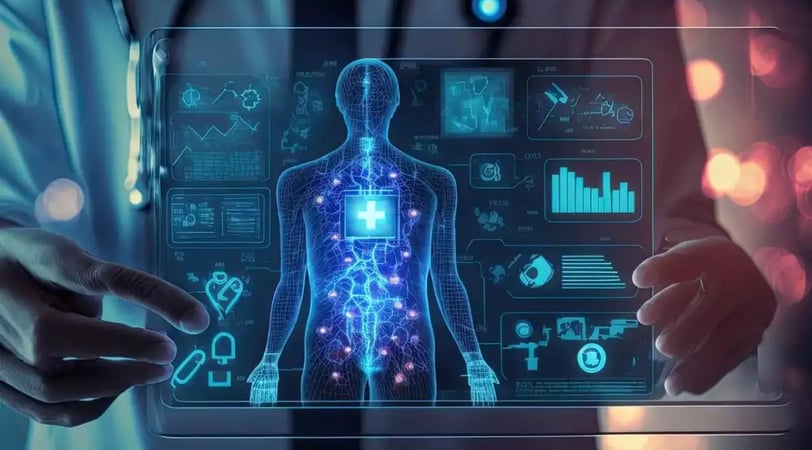Medical Imaging Trends to Watch in 2025: The Future of Diagnostics and Patient Care
As we step into 2025, the landscape of medical imaging is evolving rapidly, driven by groundbreaking technological advancements and innovations that promise to revolutionize the way we diagnose, treat, and manage medical conditions. From artificial intelligence (AI) to 3D imaging, the future of medical imaging is poised to enhance precision, accessibility, and efficiency across the healthcare industry. Here are some of the key medical imaging trends to watch in 2025.
2/1/20255 min read


1. AI and Machine Learning Integration
Artificial intelligence (AI) and machine learning (ML) technologies are transforming the healthcare field, and medical imaging is no exception. In 2025, AI will likely play a central role in the evolution of imaging technologies, especially in enhancing diagnostic accuracy, increasing workflow efficiency, and improving patient outcomes.
AI in Image Interpretation: AI-powered algorithms are already being used to assist healthcare providers in interpreting medical images such as X-rays, CT scans, and MRIs. By 2025, these systems will be even more sophisticated, helping doctors detect diseases like cancer, heart disease, and neurological disorders with greater speed and accuracy. Some AI systems can even predict disease progression, enabling more proactive treatments.
Automated Diagnostics: AI-driven diagnostic tools will help automate routine image analyses, reducing the burden on radiologists and speeding up results. AI could become an essential support tool for early disease detection, improving both the efficiency and accuracy of diagnoses.
2. Portable and Point-of-Care Imaging
One of the most exciting trends in medical imaging is the rise of portable imaging devices. These compact, lightweight devices make it possible for healthcare providers to conduct imaging in non-traditional settings, such as remote areas, emergency rooms, and even patients' homes.
Portable X-ray and Ultrasound Machines: In 2025, we’ll see a significant shift toward affordable portable X-ray systems and handheld ultrasound machines that deliver high-quality imaging at the point of care. These devices will allow doctors to perform rapid assessments, improving decision-making in emergency situations and providing immediate diagnoses.
Telemedicine Integration: Portable imaging devices will be seamlessly integrated with telemedicine platforms, allowing medical professionals to review images remotely. This will be especially valuable in rural or underserved areas where access to traditional imaging services is limited.
3. 3D and 4D Imaging Advancements
In the world of medical imaging, 3D and 4D imaging technologies are rapidly gaining momentum. These technologies provide more detailed, accurate, and dynamic images, helping doctors make better-informed decisions in a variety of medical fields.
3D Mammography: 3D mammography, also known as tomosynthesis, is already improving breast cancer detection. By 2025, this technology will be more widely adopted, offering enhanced imaging capabilities that can reduce false positives and improve early detection of breast cancer.
4D Ultrasound: In obstetrics and cardiology, 4D ultrasound will offer real-time, moving images of a fetus or the heart. This dynamic visualization can provide more detailed assessments, helping doctors monitor the health of the baby and mother throughout pregnancy, as well as real-time monitoring of heart conditions.
3D/4D Imaging for Surgery: Surgeons will increasingly rely on 3D and 4D imaging to plan and execute complex surgeries with greater precision. This technology will be especially useful for joint replacements, spinal surgeries, and neurosurgery, enabling surgeons to visualize a patient's anatomy in three dimensions.
4. Radiomics and Precision Medicine
By 2025, radiomics—the extraction of quantitative data from medical images—will become a powerful tool in the field of precision medicine. This will allow doctors to personalize treatment plans based on a patient's unique imaging data.
Tumor Characterization: Radiomics will help oncologists characterize tumors in greater detail, using CT scans, MRIs, and PET scans to analyze factors like tumor shape, texture, and density. This will allow for a more precise diagnosis of cancer and enable doctors to tailor treatments to individual patients.
Predictive Modeling: In the coming years, radiomics will be used to develop predictive models that can forecast the likelihood of disease recurrence or progression. This will enhance treatment planning and help doctors make more informed decisions.
5. Radiation Dose Reduction
Reducing radiation exposure in imaging procedures is always a top priority, and advancements in low-dose imaging technology are expected to continue to grow in 2025.
Low-Dose X-ray and CT Imaging: The latest generation of X-ray machines and CT scanners will feature advanced algorithms designed to reduce radiation doses while maintaining image quality. This is particularly important for vulnerable populations, such as pediatric patients and pregnant women.
AI-Enhanced Dose Management: AI will play a crucial role in optimizing radiation dose management. It will automatically adjust imaging parameters based on patient size, age, and clinical needs, ensuring that radiation exposure is kept to a minimum without compromising diagnostic quality.
6. Fusion Imaging Technologies
Fusion imaging technologies combine data from multiple imaging modalities to create a comprehensive view of a patient's condition. This trend is expected to grow significantly by 2025.
PET/CT: The combination of Positron Emission Tomography (PET) and Computed Tomography (CT) will become even more widespread, allowing for more accurate and detailed tumor detection and treatment monitoring, particularly in oncology.
MRI/Ultrasound: Integrating MRI and ultrasound imaging will allow for enhanced visualization of soft tissues, improving the diagnosis and management of diseases like liver conditions, heart disease, and musculoskeletal injuries.
7. Teleimaging and Cloud-Based Systems
As the healthcare industry increasingly shifts toward digital solutions, cloud-based imaging systems will gain more traction, enabling easier sharing, storage, and access to medical images.
Teleimaging: Teleimaging will become more prominent, allowing radiologists and specialists to access medical images from anywhere in the world. This will be particularly beneficial in rural or underserved areas, where specialized care may not be readily available.
AI-Driven Cloud Platforms: Cloud-based platforms will also enable the seamless integration of AI algorithms for image analysis, providing real-time, remote diagnostics. The ability to collaborate across locations and institutions will improve patient care and reduce time-to-treatment.
8. Augmented Reality (AR) and Virtual Reality (VR) in Imaging
Augmented reality (AR) and virtual reality (VR) will become essential tools in medical imaging, enhancing both training and clinical applications.
AR in Surgery: Surgeons will use AR technology to overlay real-time imaging data onto a patient's body during surgery, helping guide them in performing complex procedures. For example, AR-guided brain surgery will allow surgeons to visualize the brain's anatomy in 3D during the procedure.
VR for Medical Training: VR will become an essential tool for medical education, allowing students and professionals to practice imaging techniques, simulate surgeries, and engage in virtual diagnostic exercises in a controlled, immersive environment.
9. Wearable Imaging Devices
The future of medical imaging will include wearable devices that provide continuous monitoring and early detection of health conditions.
Wearable Ultrasound Devices: Small, wearable ultrasound devices are expected to revolutionize monitoring in areas like cardiology and pregnancy. Patients could wear these devices at home to continuously monitor their heart or fetal health, sending data directly to their healthcare provider.
Continuous Monitoring: Advances in ECG and MRI technology may lead to continuous wearable imaging devices that can help track internal conditions in real-time, providing both patients and doctors with valuable insights for ongoing care.
10. Blockchain in Medical Imaging
Blockchain technology is poised to make medical imaging more secure and reliable. By 2025, blockchain will play a critical role in managing the storage, sharing, and privacy of patient imaging data.
Data Security: Blockchain’s encryption capabilities will ensure that medical images are securely stored, preventing unauthorized access and ensuring patient privacy. This will be especially important in cloud-based systems and teleimaging platforms.






Reference Website Link:
AI and Machine Learning Integration
3D and 4D Imaging Advancements
Portable and Point-of-Care Imaging
Radiomics and Precision Medicine
